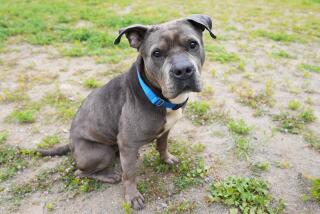Protective Vests for Police Dogs
- Share via
A robbery suspect had kept police back for 23 exhausting hours when officers pulled out their weapon: Solo, a 3-year-old German shepherd.
He had helped in 19 criminal arrests and found 11 missing people for the Monmouth County Sheriff’s Department in New Jersey. Officers knew he could flush out their man.
Solo went inside with only his fur to protect him. Within minutes, he was dead from two gunshot wounds.
His death in 1997 has helped to motivate children in more than 25 states, including Maine. They hold bake sales, wash cars and collect coins in tin cans to raise money to buy bulletproof vests to shield the officers’ best friend.
Dozens of programs work toward the same goal, including the Vested Interest Fund, a nonprofit group organized by the Associated Humane Societies after Solo’s death. But it seems that the children’s voices are having the greatest impact.
From her home in West Bath, 12-year-old Kelly Davis founded the first organization in Maine aimed at putting flak jackets on the backs of every police dog. She had raised enough money for 13 vests, at a cost of $650 apiece, since she started Maine Vest-A-Dog last November.
Her motto: “Protect the dogs that protect us.” Her goal: to outfit each of Maine’s more than 50 police dogs with a bulletproof, stab-proof vest made of the same Kevlar material used to protect officers.
“Police go into a lot of places where they have to wear bulletproof vests, and it’s nice to know they have a vest that’s going to protect the dogs too,” Kelly said.
In East Dublin, Ga., 12-year-old April Candlish raised $1,200 by making fliers on her computer and setting donation jars in stores. In Tucson, Ariz., 10-year-old Michael Valdez put 17 vests on police dogs through yard sales and selling bottled water at dog shows.
Twelve-year-old Stephanie Taylor of Oceanside, the founder of the national organization Vest-A-Dog, has raised enough money since 1999 to put bulletproof vests on more than 600 dogs.
“I feel a lot better knowing that the dogs are protected. And the officers can feel a lot safer sending their dog out there any time they go into a dangerous situation,” she said.
The fund-raising comes at a time when many police departments are too busy trying to put enough officers on the street to worry about the added expense of outfitting dogs with expensive vests.
Losing a dog, however, is not without expense.
It can cost upward of $10,000 to replace a police dog, which undergoes hundreds of hours of training, said Russ Hess, executive director of the U.S. Police Canine Assn. in Springboro, Ohio.
Although most K-9 unit dogs are males, either male or female can be trained as police dogs. The breeds, however, vary depending on the task: Black Labrador retrievers are often used for bomb sniffing, hounds in some searches, and labs, shepherds and Belgian Malinous are drug dogs. Most K-9s are hardy working dogs--shepherds or Malinous.
On average, two police dogs are killed each year in the United States, although no agency keeps track of the number of dogs killed in the line of duty the way the FBI does when officers are slain.
The emotional cost of losing a K-9 can extract its own toll on the handler, primarily because dog and officer also live together, and the bond is intense.
During the three years Mitch Lewis has handled Apache, a 4-year-old Malinous, the two have been inseparable.
“Off duty, he’s a friend; on duty, he’s a partner,” said Lewis, an officer in the Bath Police Department. “Losing a dog is a tragedy for any officer.”
Solo’s memorial service in 1998 drew more than 1,000 people, including more than 100 K-9 teams from four states. But a bulletproof vest probably would not have saved his life. Solo died from a gunshot to his head, which the vest doesn’t shield.
“Would a bulletproof vest have saved Solo? I don’t know,” Monmouth County Sheriff Joseph Oxley said. It’s like wearing a seat belt in a car, he said: It may not prevent death or injury in all circumstances, but motorists are well advised to wear one. “It’s better to have the vest on than not.”
Critics argue that the vests are hot and cumbersome, reducing the dog’s mobility and posing a potential distraction. They contend that the vests could make it easier for a suspect to grab the dog during a struggle, but some of the same arguments can be made for the bulletproof vests officers wear.
“There have been no instances of a bulletproof vest preventing a K-9 from dying from a gunshot,” Hess said. “Until we have that, there will be debate over whether the vests are necessary.”
The vests help protect dogs from knife wounds, broken ribs and bruises, Hess said. But he admits K-9s are far more likely to die from heat exhaustion from being left in a hot patrol car than from being shot.
Hess knows of two dogs killed last year by gunshots. And in 1999, two police dogs in Jacksonville, Fla., were killed within a month of each other.
Only one police dog has been shot in the line of duty in Maine, a German shepherd, in 1981. His name was Ben.
He survived.
More to Read
Sign up for Essential California
The most important California stories and recommendations in your inbox every morning.
You may occasionally receive promotional content from the Los Angeles Times.










